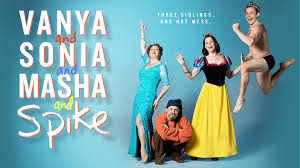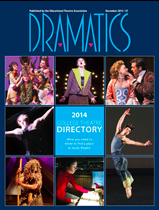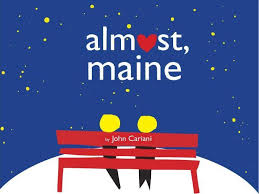Aside from being the month of copious pumpkin flavored foodstuffs, October also brings two perennial theatrical top ten lists that are worthy of note: American Theatre magazine’s list of the most produced plays in Theatre Communications Group theatres for the coming season and Dramatics magazine’s lists of the most produced plays, musicals and one-acts in high school theatre for the prior year. They both say a great deal about the state of theatre in their respective spheres of production, both by what’s listed explicitly, as well as by what doesn’t appear.
In the broadest sense, both lists are startlingly predictable, although for different reasons. If you happen to find a bookie willing to give you odds on predicting the lists, here’s the trick for each: for the American Theatre list, bet heavily on plays which appeared on Broadway, or had acclaimed Off-Broadway runs, in the past year or two. For the Dramatics list, bet heavily on the plays that appeared on the prior year’s list.
But in the interest of learning, let’s unpack each list not quite so reductively.
American Theatre
 As I’ve written in the past, what happens in New York theatre is a superb predictor of what will happen in regional theatre in the coming seasons, especially when it comes to plays. Any play that makes it to Broadway, or gets a great New York Times review, is going to grab the attention of regional producers. Throw in Tony nominations, let alone a Tony win – or the Pulitzer – and those are the plays that will quickly crop up on regional theatre schedules.
As I’ve written in the past, what happens in New York theatre is a superb predictor of what will happen in regional theatre in the coming seasons, especially when it comes to plays. Any play that makes it to Broadway, or gets a great New York Times review, is going to grab the attention of regional producers. Throw in Tony nominations, let alone a Tony win – or the Pulitzer – and those are the plays that will quickly crop up on regional theatre schedules.
Anyone who follows the pattern of production would have easily guessed that Christopher Durang’s Vanya and Sonia and Masha and Spike would proliferate this year, being a thoughtful, literary based comedy with a cast of only six. That American Theatre lists 27 productions doesn’t even take into account the 11 theatres that did the show in 2013-14, and certainly there are non-TCG theatres which are doing the show as well. It’s no surprise that Durang has said he made more money this past year than in any other year of his career; it’s a shame that financial success has taken so long for such a prodigiously gifted writer and teacher.
In general, shows on the American Theatre list have about a three year stay, typically peaking in their second year on the list, but this can vary depending upon when titles are released by licensing houses and agents to regional theatres. 25 years ago (and more significantly years before that) theatres might have had to compete with commercial tours, but play tours are exceedingly rare birds these days, if not extinct.
 Perhaps this rush to the familiar and popular and NYC-annointed is disheartening, but it’s worth observing that the American Theatre list notes how many productions each title gets, and that after the first couple of slots, we’re usually looking at plays that are getting 7 or 8 productions in a given season, across TCG’s current universe of 474 member companies (404 of which were included in this year’s figures). Since the magazine notes a universe of 1,876 productions, suddenly 27 stagings of a single show doesn’t seem so dominant after all. Granted, TCG drops Shakespeare from their calculations, but even he only counted for 77 productions of all of his plays across this field. So reading between the lines, the American Theatre list suggests there’s very little unanimity about what’s done at TCG member theatres in any given year, a less quantifiable achievement but an important one.
Perhaps this rush to the familiar and popular and NYC-annointed is disheartening, but it’s worth observing that the American Theatre list notes how many productions each title gets, and that after the first couple of slots, we’re usually looking at plays that are getting 7 or 8 productions in a given season, across TCG’s current universe of 474 member companies (404 of which were included in this year’s figures). Since the magazine notes a universe of 1,876 productions, suddenly 27 stagings of a single show doesn’t seem so dominant after all. Granted, TCG drops Shakespeare from their calculations, but even he only counted for 77 productions of all of his plays across this field. So reading between the lines, the American Theatre list suggests there’s very little unanimity about what’s done at TCG member theatres in any given year, a less quantifiable achievement but an important one.
Dramatics
 While titles come and go on the American Theatre list, stasis is the best word to describe the lists of most produced high school plays (it’s somewhat less true for musicals). Nine of the plays on the 2014 list were on the 2013 list; 2014 was topped by John Cariani’s Almost, Maine, followed by A Midsummer Night’s Dream and the two titles were in reverse order the prior year. The other duplicated titles were Our Town, 12 Angry Men (Jurors), You Can’t Take It With You, Romeo and Juliet, The Crucible, Harvey and The Importance of Being Earnest.
While titles come and go on the American Theatre list, stasis is the best word to describe the lists of most produced high school plays (it’s somewhat less true for musicals). Nine of the plays on the 2014 list were on the 2013 list; 2014 was topped by John Cariani’s Almost, Maine, followed by A Midsummer Night’s Dream and the two titles were in reverse order the prior year. The other duplicated titles were Our Town, 12 Angry Men (Jurors), You Can’t Take It With You, Romeo and Juliet, The Crucible, Harvey and The Importance of Being Earnest.
Like the American Theatre list, the Dramatics survey doesn’t cover the entirety of high school theatre production; only those schools that are members of the Educational Theatre Association’s International Thespian Society have the opportunity to participate, representing more than 4,000 high schools out of a universe of 28,500 public, private and parochial secondary schools in the country. Unlike the Dramatics list, there are no hard numbers about how many productions each show receives, so one can only judge relative popularity.
 Almost, Maine’s swift ascension to the top rungs of the list is extraordinary, but it’s due in no small part to its construction as a series of thematically linked scenes, originally played by just four actors but easily expandable for casts where actor salaries aren’t an issue. Looking at recent American Theatre lists, they tend to be topped by plays with small casts (Venus in Fur, Red, Good People and The 39 Steps), while the Dramatics list is the reverse, with larger cast plays dominating, in order to be inclusive of more students (though paling next to musicals where casts in school shows might expand to 50 or more).
Almost, Maine’s swift ascension to the top rungs of the list is extraordinary, but it’s due in no small part to its construction as a series of thematically linked scenes, originally played by just four actors but easily expandable for casts where actor salaries aren’t an issue. Looking at recent American Theatre lists, they tend to be topped by plays with small casts (Venus in Fur, Red, Good People and The 39 Steps), while the Dramatics list is the reverse, with larger cast plays dominating, in order to be inclusive of more students (though paling next to musicals where casts in school shows might expand to 50 or more).
The most important trend on the Dramatics list (which has been produced since 1938) is the lack of trends. Though a full assessment of the history of top high school plays would take considerable effort, it’s worth noting that Our Town was on the list not only in 2014 and 2013, but also in 2009, 1999 and 1989; the same is true for You Can’t Take It With You. Other frequently appearing titles are Arsenic and Old Lace, various adaptations of Alice in Wonderland, Harvey, and The Miracle Worker.
No doubt the lack of newer plays with large casts is a significant reason why older classic tend to rule this list; certainly the classic nature of these works and their relative lack of controversial elements play into it as well. But as I watched Sheri Wilner’s play Kingdom City at the La Jolla Playhouse a few weeks ago, in which a drama director is compelled to choose a play from the Dramatics list, I wondered: is the list self-perpetuating? Are there numerous schools that seek what’s mainstream and accepted at other schools, and so do the same plays propagate themselves because administrators see the Dramatics list as having an implied educational seal of approval?
That may well be, and if it’s true, it’s an unfortunate side effect of a quantitative survey. But it’s also worth noting that many of these plays, vintage though they may be, have common themes, chief among them exhortations to march to your own drummer, to matter how out of step you may be to the conventional wisdom. They may be artistic expressions from other eras about the importance of individuality, but in the hands of teachers thinking about more than just placating parents, they are also opportunities to celebrate those among us who may seem different or unique, and for fighting for what you believe in against prevailing sentiment or structures.
* * *
Looking at musicals on the American Theatre list is a challenge, because their list is an aggregate of plays and musicals, and while many regional companies now do a musical or two, it’s much harder for any groundswell to emerge. In the last five years, only three musicals have made it onto the TCG lists, each for one year only: Into The Woods, Spring Awakening and The 25th Annual Putnam County Spelling Bee. That doesn’t mean there’s a dearth of musical production, it simply shows that the work is being done by companies outside of the TCG universe.
 Musicals are of course a staple of high school theatre, but the top ten lists from Dramatics are somewhat more fluid. While staples like Guys and Dolls, Grease, Once Upon a Mattress, You’re A Good Man Charlie Brown and Little Shop of Horrors maintain their presence, newer musicals arrive every year or two, with works like Seussical, Legally Blonde, Spelling Bee, and Thoroughly Modern Millie appearing frequently in recent years. At the peak spot, after a six-year run, Beauty and the Beast was bested this year by Shrek; as with professional companies, when popular new works are released into the market, they quickly rise to the top. How long they’ll stay is anyone’s guess, but I have little doubt that we’ll one day see Aladdin and Wicked settle in for long tenures.
Musicals are of course a staple of high school theatre, but the top ten lists from Dramatics are somewhat more fluid. While staples like Guys and Dolls, Grease, Once Upon a Mattress, You’re A Good Man Charlie Brown and Little Shop of Horrors maintain their presence, newer musicals arrive every year or two, with works like Seussical, Legally Blonde, Spelling Bee, and Thoroughly Modern Millie appearing frequently in recent years. At the peak spot, after a six-year run, Beauty and the Beast was bested this year by Shrek; as with professional companies, when popular new works are released into the market, they quickly rise to the top. How long they’ll stay is anyone’s guess, but I have little doubt that we’ll one day see Aladdin and Wicked settle in for long tenures.
* * *
When I looked at both the American Theatre and Dramatics lists over a span of time, the distinct predictability of each was troubling. Coming out when they do, before most theatrical production for the next theatre season is set, I’d like to see them looked at not as any manner of affirmation, but as a challenge – whether to professional companies or school schedules. I admire and enjoy the plays that are listed here, and nothing herein should be construed as critical of any of these shows; audiences around the country deserve the opportunity to see them. While I do have the benefit of living in New York and seeing most of these popular shows there, I must confess that I am most intrigued by the theatre companies and school groups that might just say to themselves, ‘Let’s not do the shows, or too many of the shows, that appear on these lists. Let’s find something else.’ Those plays may never appear as part of any aggregation, but I suspect the groups’ work will be all the more interesting for it, benefiting both artists and audiences.




I always look at both of theses lists to see where my high school program fits in with the rest of the theatrical universe. It’s disappointing to see so many regional theaters producing the same shows. Its like they all take last years broadway and off broadway hits and reproduce them. What happened to world premiers??? Hartford Stage took a chance with The Gentleman’s Guide last year and look how that worked out. ART in Boston has been having huge success in the last few years producing new works. Isn’t this what regional theater is for?
It is also disappointing to see my high school colleagues not venturing into newer, edgier plays. Sure we have produced Almost, Maine and 12 Angry Jurors. But we have also produced much darker more contraversial plays that push the student performers and create discussions with their audience. It just seems like some schools are on an endless loop of Midsummers, You Cant take it With you, The Crucible and Our Town. Not that this plays shouldn’t be taught. They are classics for a reason. But shake it up once in a while! Your students will thank you for it! Don’t get me started on the musical list. Like the world needs another High School production of Grease.
I am interested in the titles of some of the darker/controversial plays you have produced.
Sure,
Whose Life is it Anyway? by Brian Clarke
The Laramie Project by Moises Kaufmann
And then they Came for me… by James Still
Bang Bang Your Dead by William Mastrosimone
New York by David Rimmer
I’m actually pleased to see Almost, Maine on the high school list, given the one gay-themed sketch.
A high school in North Carolina has just canceled ALMOST, MAINE, with the production already in rehearsal: http://www.wsoctv.com/news/news/local/school-pulls-curtains-controversial-play/nhjX7/?__federated=1